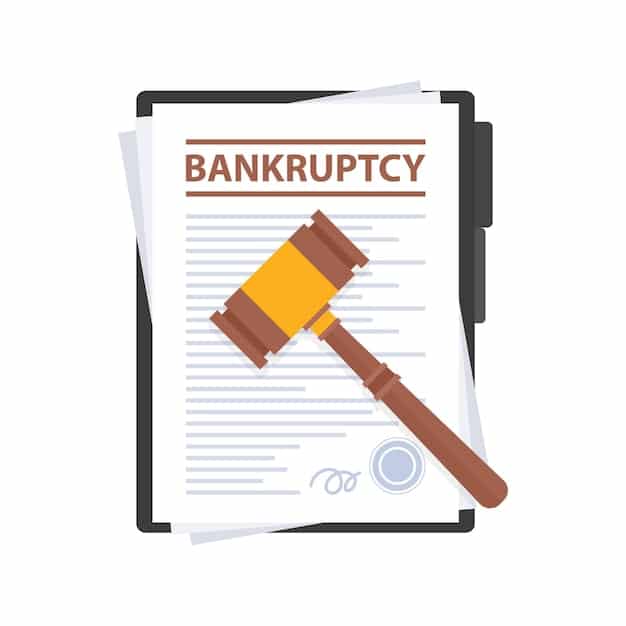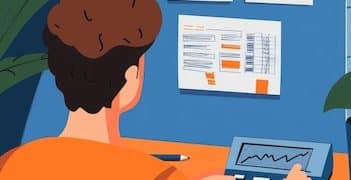Navigating Bankruptcy Options: Chapter 7 and Chapter 13 Guide

Navigating debt relief is a complex process, and understanding the differences between Chapter 7 and Chapter 13 bankruptcy options is crucial for individuals seeking a financial fresh start under U.S. law.
Facing overwhelming debt can feel like being lost in a dense fog, where every path seems to lead to more uncertainty. For countless Americans, the prospect of bankruptcy emerges as a beacon of hope, but the decision of which chapter to pursue—specifically, between Bankruptcy Options: A Comprehensive Guide to Debt Relief Under Chapter 7 and Chapter 13—is often fraught with complexity. This guide aims to demystify these critical paths to financial recovery, offering clarity and empowering individuals to make informed choices about their future.
Understanding the Landscape of Personal Bankruptcy
Personal bankruptcy, while often viewed with apprehension, is a fundamental component of the U.S. legal system designed to provide a fresh start for individuals unable to meet their financial obligations. It’s not a punishment, but rather a structured legal process to either liquidate assets to pay creditors or to reorganize debts into a manageable plan. The two primary avenues for consumer bankruptcy are Chapter 7 and Chapter 13, each with distinct features, eligibility requirements, and outcomes that cater to different financial situations.
The choice between these two chapters is rarely straightforward and depends heavily on an individual’s income, assets, and the nature of their debts. A common misconception is that bankruptcy is a uniform process; however, the nuances between Chapter 7 and Chapter 13 are profound, impacting everything from the types of debts that can be discharged to the duration of the repayment period. Understanding these foundational differences is the first step toward determining the most appropriate course of action.
The Purpose of Personal Bankruptcy
At its core, personal bankruptcy serves two major purposes: providing relief for the debtor and ensuring a fair distribution of assets to creditors. For debtors, it offers a legal mechanism to eliminate or restructure debts, stopping harassing collection calls and preventing foreclosures or repossessions, at least temporarily. For creditors, it ensures an orderly process for collecting debts, even if it means receiving less than the full amount owed.
- Protects debtors from creditor harassment.
- Provides a path to financial fresh start.
- Ensures fair debt distribution among creditors.
The legal framework surrounding bankruptcy is robust, governed by federal law, meaning the basic rules are consistent across all states. However, state laws can influence certain aspects, particularly regarding property exemptions. This interplay between federal and state laws adds another layer of complexity, underscoring the importance of informed legal counsel throughout the process.
Chapter 7 Bankruptcy: The Liquidation Path
Chapter 7 bankruptcy, often referred to as “liquidation bankruptcy,” is designed for individuals with limited income who cannot afford to repay their debts. In this process, a bankruptcy trustee is appointed to sell certain non-exempt assets to pay off creditors. The goal is to discharge most unsecured debts, such as credit card balances, medical bills, and personal loans, providing the debtor with a clean slate.
This chapter is typically faster than Chapter 13, with the entire process often concluding within four to six months. However, it requires applicants to pass a “means test,” which evaluates their income against the median income in their state. If their income is too high, they may not qualify for Chapter 7 and might instead need to pursue Chapter 13.
Eligibility and the Means Test
The means test is a critical gatekeeper for Chapter 7. It prevents individuals who have the financial capacity to repay their debts from simply liquidating them. The test primarily compares the debtor’s average monthly income over the past six months to the median income for a household of the same size in their state. If the income is below the median, they generally qualify. If it’s above, further calculations involving allowed expenses are made to determine if there is enough disposable income to fund a Chapter 13 repayment plan.
- Income is below state median.
- If above median, no disposable income after expenses.
- Prevents abuse of the bankruptcy system.
Another key aspect of Chapter 7 is the concept of exempt property. While the purpose is liquidation, debtors are allowed to keep certain essential assets. These exemptions vary by state, but commonly include primary residences (up to a certain value), necessary household goods, tools of trade, and retirement accounts. Understanding these exemptions is crucial, as they determine what assets a debtor can retain post-bankruptcy.

The Discharge of Debts in Chapter 7
The primary benefit of Chapter 7 is the discharge of most unsecured debts. Once a debt is discharged, the debtor is no longer legally obligated to pay it. This offers immense relief and a genuine fresh financial start. However, not all debts are dischargeable. Certain debts, such as most student loans, child support, alimony, recent taxes, and debts incurred through fraud, typically survive bankruptcy. This is an important distinction to consider when evaluating debt relief options.
Secured debts, like mortgages and car loans, are also handled differently. A debtor can choose to reaffirm these debts (agree to continue paying them), redeem the property (pay its market value), or surrender the property. The decision depends on the debtor’s desire to keep the asset and their ability to continue making payments. For those seeking immediate relief from insurmountable unsecured debt, Chapter 7 often presents the most direct and effective solution.
Chapter 13 Bankruptcy: The Reorganization Plan
Unlike Chapter 7, Chapter 13 bankruptcy is a “reorganization bankruptcy” designed for individuals with regular income who can afford to repay some or all of their debts over time. Instead of liquidating assets, debtors propose a repayment plan, typically lasting three to five years, to their creditors. This plan must be approved by the bankruptcy court and a trustee is appointed to oversee the payments and ensure the plan is followed.
Chapter 13 is often chosen by individuals who don’t qualify for Chapter 7 due to higher income or those who wish to protect specific assets, such as a home facing foreclosure, by catching up on missed payments through the plan. It also offers the ability to “cram down” certain secured debts, reducing the principal balance to the fair market value of the collateral, and to cure mortgage arrearages.
Eligibility and Repayment Plans
To be eligible for Chapter 13, debtors must have a steady income stream to fund their repayment plan. There are also limits on the amount of secured and unsecured debt an individual can have. These limits are adjusted periodically, so it’s essential to check the current thresholds. The repayment plan proposal details how the debtor will pay various types of creditors, including priority debts (like taxes and child support), secured debts (like car loans), and unsecured debts.
- Regular income source is mandatory.
- Debt limits apply to both secured and unsecured.
- Plan includes priority, secured, and unsecured debts.
The payment plan must allocate all of the debtor’s disposable income toward paying creditors. Disposable income is generally defined as income remaining after payment of reasonably necessary living expenses. The plan must also meet the “best interest of creditors” test, meaning unsecured creditors must receive at least as much as they would have under a Chapter 7 liquidation. If successful, at the end of the plan term, any remaining dischargeable unsecured debts are eliminated.
Advantages of Chapter 13
Chapter 13 offers several distinct advantages, particularly for homeowners and those with valuable assets they wish to protect. It provides an opportunity to prevent foreclosure and repossession by allowing debtors to catch up on missed payments through the repayment plan. It can also protect co-signers on personal debts, as the plan can include provisions for paying these debts directly.
Another significant benefit is the ability to strip off junior liens on a primary residence if the home’s value is less than the senior mortgage. This can effectively convert a secured debt into an unsecured debt, which might then be partially or fully discharged at the end of the plan. For those facing complex financial situations that require more flexibility and control over their assets, Chapter 13 provides a structured and powerful solution.
Key Differences and Decision Factors
The choice between Chapter 7 and Chapter 13 hinges on several critical factors, including income, assets, and the types of debts involved. Understanding these distinctions is paramount in determining the most suitable bankruptcy path. Chapter 7 is typically for those with lower incomes and fewer assets, aiming for a swift discharge of most unsecured debts through liquidation. Chapter 13, on the other hand, is designed for individuals with regular income who can commit to a repayment plan, allowing them to retain assets and restructure debts over time.
A primary differentiator is the “means test.” Failing the means test for Chapter 7 often pushes debtors towards Chapter 13. Furthermore, the duration of the process varies significantly: Chapter 7 is usually complete in a few months, while Chapter 13 spans three to five years. Each chapter has implications for credit scores and future financial activities, but both ultimately offer a path to recovery from unbearable debt burdens.
Asset Retention and Debt Discharge
Under Chapter 7, non-exempt assets may be liquidated by a trustee to pay creditors. While a debtor can keep exempt property, anything beyond that is at risk. In contrast, Chapter 13 allows debtors to keep all their assets, as long as they can propose and successfully complete a repayment plan that meets specific legal criteria. This is a significant consideration for individuals with substantial equity in their homes or other valuable possessions.
- Chapter 7: Non-exempt assets at risk of liquidation.
- Chapter 13: All assets retained, provided plan is completed.
- Exemption laws vary by state.
Regarding debt discharge, Chapter 7 generally discharges most unsecured debts relatively quickly. Chapter 13 also discharges unsecured debts at the end of the repayment plan, but it provides a “super discharge” for certain debts not dischargeable in Chapter 7, such as non-support marital debts incurred through a divorce decree. This expanded discharge can be a compelling reason for some to choose Chapter 13, despite the longer commitment.
The Bankruptcy Process: Step-by-Step Overview
Irrespective of whether an individual chooses Chapter 7 or Chapter 13, the bankruptcy process follows a general sequence of steps, beginning with pre-filing credit counseling and culminating in a discharge of debts. While the specifics of each chapter introduce variations, the overarching framework provides a systematic approach to debt relief. Navigating these steps requires careful attention to detail and adherence to legal requirements.
The process always starts with a consultation with an attorney, who helps determine the most appropriate chapter, gathers necessary documentation, and prepares the petition. This initial phase is crucial for laying a strong foundation for a successful bankruptcy filing and avoiding common pitfalls. Understanding each stage can help alleviate some of the anxiety associated with filing for bankruptcy.
Pre-Filing Requirements and Petition
Before filing for bankruptcy, debtors are required to complete a credit counseling course from an approved agency. This course aims to assess the debtor’s financial situation and explore alternatives to bankruptcy. Once counseling is complete, the bankruptcy petition and schedules are prepared. These documents provide a comprehensive overview of the debtor’s financial life, including income, expenses, assets, liabilities, and a list of creditors.
Accuracy and completeness in preparing these documents are paramount, as any inconsistencies or omissions can lead to delays or even dismissal of the case. The attorney plays a critical role in ensuring all information is correctly presented and that all necessary forms are filed with the bankruptcy court. This preparation phase is the most labor-intensive part of the entire process.
The Meeting of Creditors (341 Meeting)
Approximately one month after filing the petition, debtors must attend a “Meeting of Creditors,” also known as the 341 meeting. Despite its intimidating name, creditors rarely attend, and the meeting is primarily conducted by the bankruptcy trustee. The purpose is for the trustee to verify the information in the petition under oath, ask questions about the debtor’s assets, debts, and financial affairs, and ensure there is no fraud involved.

This meeting is usually brief and straightforward, especially if the petition was well-prepared. Following the 341 meeting, debtors are required to complete a second course, called a Debtor Education course, focusing on personal financial management. Completion of both courses is a prerequisite for receiving a debt discharge.
Life After Bankruptcy: Rebuilding Your Financial Future
The successful completion of a bankruptcy case, whether Chapter 7 or Chapter 13, marks the beginning of a new financial chapter. While the immediate aftermath might include a lower credit score, bankruptcy offers the invaluable opportunity for a fresh start, free from the burden of overwhelming debt. Rebuilding credit and establishing sound financial habits are key to long-term financial health.
It’s a misconception that bankruptcy permanently ruins one’s credit. While it remains on a credit report for several years (7 for Chapter 13, 10 for Chapter 7), many individuals begin to rebuild their credit surprisingly quickly. The key is to be proactive and strategic in managing finances post-bankruptcy. This includes obtaining new credit, making timely payments, and saving for emergencies.
Rebuilding Credit and Financial Habits
One of the first steps in rebuilding credit is acquiring a secured credit card. These cards require a deposit, which serves as the credit limit, minimizing risk for lenders. By using it responsibly and paying the balance in full each month, individuals can demonstrate a positive payment history. Another option is a small, secured loan, specifically designed to help build credit.
- Obtain a secured credit card.
- Take out a small, secured credit-builder loan.
- Make all payments on time and in full.
Equally important is establishing new, sound financial habits. This includes creating and sticking to a budget, building an emergency fund, and living within one’s means. Bankruptcy provides a hard reset, offering a unique opportunity to redefine one’s relationship with money and adopt practices that promote financial stability and growth.
Long-Term Financial Planning
Long-term financial planning after bankruptcy should focus on sustained growth and achieving future financial goals. This might involve setting up automated savings, investing in retirement accounts, and monitoring credit reports regularly for accuracy. Understanding the reasons that led to bankruptcy is crucial for avoiding similar pitfalls in the future.
Seeking guidance from financial advisors can also be beneficial in developing a robust long-term financial strategy. The journey after bankruptcy is not just about recovering, but about thriving. With discipline, education, and proactive management, individuals can indeed achieve a strong and secure financial future, leaving past debt burdens behind.
Navigating the Legal Landscape: When to Seek Professional Help
While this guide provides a comprehensive overview of Chapter 7 and Chapter 13 Bankruptcy Options: A Comprehensive Guide to Debt Relief Under Chapter 7 and Chapter 13, it is imperative to recognize that bankruptcy law is incredibly complex and nuanced. Self-filing, though technically possible, is rarely advisable. The risk of errors, missed deadlines, or incorrect interpretations of the law can lead to significant negative consequences, including the dismissal of the case or the loss of valuable assets.
A qualified bankruptcy attorney can provide invaluable assistance throughout the entire process, from initial consultation to discharge. They can help evaluate your financial situation, determine eligibility for each chapter, accurately prepare and file all necessary documents, represent you at the Meeting of Creditors, and navigate any issues that may arise. Their expertise ensures that your rights are protected and that you achieve the best possible outcome.
The Value of a Bankruptcy Attorney
An attorney specializing in bankruptcy law brings a wealth of knowledge and experience to the table. They are familiar with federal and state exemption laws, the intricacies of the means test, and the requirements for a successful repayment plan in Chapter 13. They can identify potential pitfalls, such as preferential transfers or fraudulent conveyances, which could jeopardize your case if not properly addressed.
- Expert knowledge of complex bankruptcy laws.
- Accurate document preparation and filing.
- Representation at court hearings and creditor meetings.
Beyond the technical aspects, an attorney can also offer peace of mind during what is often a highly stressful period. They can communicate directly with creditors, halting collection efforts and ensuring that you are not subjected to unlawful harassment. This professional guidance is an investment in your financial future, helping you to make informed decisions and secure the fresh start you deserve.
| Key Point | Brief Description |
|---|---|
| ⚖️ Chapter 7 Essential | Liquidation for low-income individuals, discharging most unsecured debts, subject to a “means test.” |
| 📅 Chapter 13 Overview | Reorganization for regular income earners with a 3-5 year repayment plan, allowing asset retention. |
| 🔑 Key Decision Factors | Income level, types of debts, and desired asset retention critically influence the choice between chapters. |
| ✅ Post-Bankruptcy Steps | Focus on rebuilding credit and financial habits, adopting budgeting, saving, and responsible credit use. |
Frequently Asked Questions About Bankruptcy Options
The means test determines if an individual’s income is low enough to qualify for Chapter 7. It compares the debtor’s average monthly income to the median income in their state for a similar household size. If above the median, further calculations on disposable income are made to prevent wealthier individuals from liquidating debts.
It depends on state exemption laws and whether you are current on payments for secured debts. If your equity in these assets is protected by exemptions, you may keep them. You can also reaffirm the debt (agree to continue paying) or redeem the property by paying its market value.
Certain debts are typically not dischargeable in either Chapter 7 or Chapter 13. These commonly include most student loans, child support and alimony, recent tax obligations, debts incurred through fraud, and fines or penalties owed to government agencies. Consult an attorney for specific debt categories.
Filing for Chapter 13 bankruptcy immediately halts foreclosure proceedings through an “automatic stay.” The repayment plan allows you to catch up on missed mortgage payments over three to five years, protecting your home as long as you adhere to the plan and make all future payments.
Chapter 7 bankruptcy typically remains on your credit report for 10 years from the filing date. Chapter 13 bankruptcy remains for 7 years from the filing date. While significant, it is possible to begin rebuilding credit effectively well before these periods expire.
Conclusion
Navigating the complex world of personal finance, especially when debt becomes unmanageable, can be daunting. Yet, understanding the intricacies of Bankruptcy Options: A Comprehensive Guide to Debt Relief Under Chapter 7 and Chapter 13 empowers individuals to regain control and secure a healthier financial future. Both Chapter 7 and Chapter 13 offer viable pathways to debt relief, each tailored to different financial circumstances and objectives. While Chapter 7 provides a quicker liquidation process for those with limited income, Chapter 13 offers a structured repayment plan allowing for asset retention over a longer period. The decision between these two fundamental chapters necessitates careful consideration of income, assets, debt types, and long-term financial goals. Crucially, the journey through bankruptcy, from pre-filing requirements to rebuilding credit, is best navigated with the experienced guidance of a qualified attorney. This professional support ensures compliance with legal complexities, protects debtor rights, and ultimately paves the way for a genuine fresh financial start, fostering a resilient and informed approach to personal wealth management.





